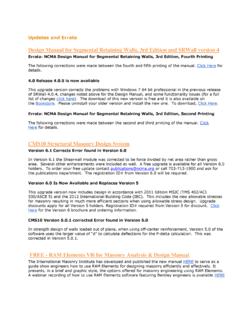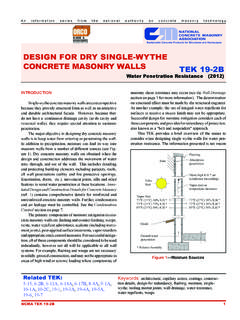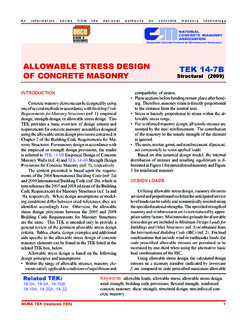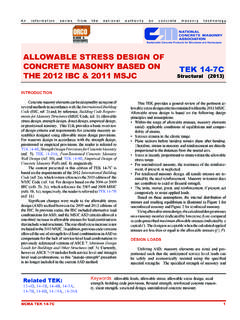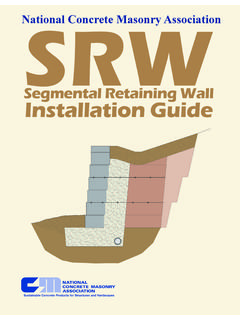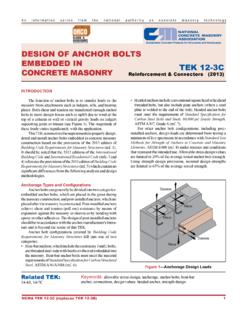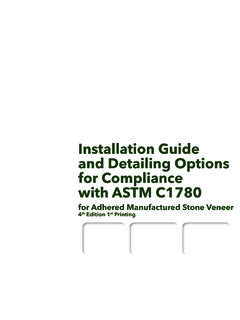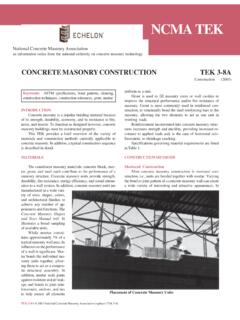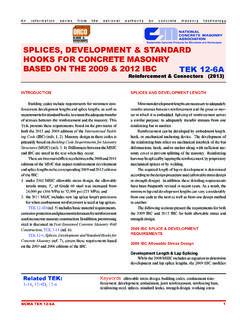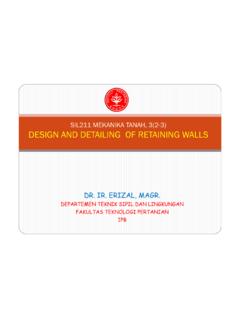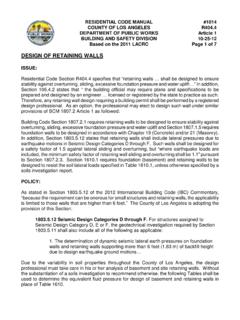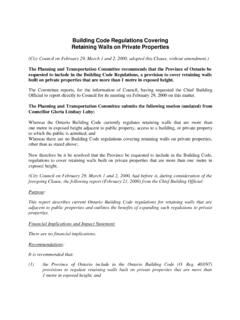Transcription of Segmental Retaining Walls Best Practices Guide
1 Segmental Retaining Walls best Practices Guide for the Specification, design , Construction, and Inspection of SRW SystemsSegmental Retaining Walls best Practices Guide Table of Contents | 1 About NCMA 3 Acknowledgments 3 Preface 4 Chapter 1 Preconstruction Considerations 5 1 1 design Roles and Responsibilities 6 1 1 1 Site Civil Engineer Responsibilities 6 1 1 2 SRW design Engineer Responsibilities 6 1 2 Planning Considerations 7 1 2 1 Project Objectives
2 7 1 2 2 Site Planning and Layout 8 1 2 3 Geotechnical Report 8 1 2 4 SRW Construction Drawing Submittals 8 1 2 5 Project Bidding 9 1 2 6 Preconstruction Meetings 9 1 3 General design Considerations 9 1 3 1 Wall Embedment Depth 11 Chapter 2 SRW Units and Geosynthetic Materials 13 2 1 SRW Units 13 2 1 1 Minimum Property Requirements for SRW Units 13 2 1 2 Freeze/Thaw Durability Requirements 14 2 1 3 Sulfate Resistance 16 2 2 Geosynthetic Reinforcement 16 2 3 Geotextile Material (Filter Fabric)
3 17 Chapter 3 Soils and Compaction 19 3 1 On-Site Soils 20 3 2 Foundation Soils 20 3 3 Reinforced Soils 20 3 4 Retained Soils 21 3 5 Gravel Fill 21 3 6 Compaction Requirements at the Wall Face 22 Soil Parameter Verification 22 3 8 Inspection and Testing Recommendations 22 Chapter 4 Water Management.
4 General design Considerations 23 4 1 Water Management 24 4 1 1 Surface Water 24 4 1 2 Below Grade Water 25 Chapter 5 Construction Considerations 31 5 1 Contractor Experience 31 5 2 Leveling Pad 31 5 3 Drain Pipe 31 5 4 SRW Unit Placement 32 5 5 Compaction Requirements 32 5 6 Water Management during Construction 32 5 7 Capping and Finish Grading 32 5 8 Wall Step-Ups in Base Course 32 5 9 Stair Considerations 33 5 10 Construction Tolerances 33 5 11 Construction Safety 33 Table of Contents | Segmental Retaining Walls best Practices GuideSegmental Retaining Walls best Practices Guide | 32 | Table of Contents National Concrete Masonry Association | 6 Geosynthetic Reinforcement Installation 35 6 1 General 36 6 1 1 Proper
5 Orientation of Geogrid and Placement 36 Chapter 7 Inspection and Quality Assurance 37 7 1 Overview 37 7 2 Soil Inspection and Testing 37 7 3 SRW Units 37 7 4 Geosynthetic Reinforcement 37 Chapter 8 Tall Walls 39 8 1 Tall Walls 40 Select Granular Backfill 40 8 1 2 Compaction Requirements 40 8 1 3 Gravel Fill at the Face 40 8 1 4 Quality Control.
6 Quality Assurance 40 8 2 SRW Unit Height Tolerances 41 8 3 Cracking 41 Chapter 9 Global Stability 43 9 1 General 44 9 1 1 Wall Embedment with Toe Slope 44 9 1 2 When to Analyze Global Stability 44 9 1 3 Increase Global Stability Options 44 Chapter 10 Terraced Walls 45 10 1 Tiered or Terraced Walls 46 Chapter 11 Water Applications 47 11 1 Water Applications 48 Chapter 12 Seismic Considerations 49 12 1 Seismic Considerations 50 Chapter 13 Above Wall Considerations 51 13 1 Above the Wall Considerations 52 13 1 1 Minimum Geogrid Lengths at the Top of the Wall 52 13 1 2 Fences and Railings 52 Traffic Barriers and Guide Rails 52 13 1 4 Slopes Above the Wall 52 13 1 5 Landscaping
7 52 Chapter 14 Corners and Radii 53 14 1 General 54 Chapter 15 Checklists 57 15 1 Preconstruction Checklist 57 15 2 design Checklist 57 15 3 Construction and Inspection Checklist 57 15 4 Post Construction Checklist 59 Chapter 16 Notations 61 Chapter 17 References 63 Table of Contents | Segmental Retaining Walls best Practices GuideSegmental Retaining Walls best Practices Guide for the Specification, design , Construction, and Inspection of SRW SystemsAbout NCMAA cknowledgmentsThe National Concrete Masonry Association (NCMA)
8 Is an international trade association representing producers and suppliers in the concrete masonry and hardscape industry The Association is dedicated to the advancement of manufactured concrete products through research, promotion, education, and the development of manufacturing guides, design codes and resources, testing standards, and construction Practices NCMA promotes the use of Segmental Retaining wall products through the development and dissemination of technical information This Guide was prepared by NCMA and is intended for use by those involved in the specification, design , construction, inspection, and maintenance of SRW systems The material presented herein has been reviewed by numerous individuals from a variety of backgrounds to ensure the enclosed information is accurate and conforms to current engineering Practices NCMA assumes no responsibility for errors or omissions resulting from the use of this Guide All illustrations and other graphic representation published in this manual are property of NCMA unless otherwise noted The efforts undertaken by Allan Block Corporation in the initial drafting of this publication are greatly appreciated as is the support and commitment of NCMA s SRW Technical Subcommittee Additional reviewers and contributors to this Guide include: Don Armstrong, Anchor Wall Systems/Oldcastle; Tim Bott, Allan Block Corporation; Glenn Herold, Oaks Concrete; Rich Lovdal, Allan Block Corporation; Karen Nelson, Versa-Lok Corporation; David Pitre, Pavestone Systems; Robert Race, Race Engineering.
9 Scott Vollmer, Oldcastle 2016 National Concrete Masonry Association | 13750 Sunrise Valley Drive | Herndon, VA 20171 | www ncma orgNCMA Publication Number: TR308 Edition: 1 Printing: 1 - Last Revised March 18, 2016 Segmental Retaining Walls best Practices Guide Chapter One Preconstruction Considerations | 54 | Preface National Concrete Masonry Association | capFinished gradeFoundation soilReinforced soilGeogrid reinforcementRetained soil, see Section ,free-draining,granular gravel fillDrain pipe, see Chapter 4 and Section drainageFilter fabric to be placed between topsoil and gravel fillThe top layer of geogrid should be placed no deeper than two courses (plus cap) or 24 in. (610 mm)First layer of geogrid should be placed on the top of the first or second course of block8 in. (230 mm) finish grading; consisting of: 4 in. (102 mm) topsoil, and 4 in. (102 mm) low permeability soilEmbedment depthLeveling padSRW unitTotal wall heightExposed wall heightChapter One | Preconstruction Considerations PrefaceFigure 1 | General Criteria Foundation soil see Section 3 2 Reinforced soil soil placed within the zone of reinforcement (Section 3 3) For tall Walls , see Section 8 1 1 Gravel fill minimum of 12 in (305 mm) gravel fill placed behind block with not less than 24 in (610 mm)combined unit/gravel fill thickness (Section ).
10 For tall Walls , see Section 8 1 3 Embedment depth determined by the SRW design engineer in conjunc-tion with the site civil engineer (Sec-tion 1 3 1) For water applications, see Section 4 1 2 and Chapter 11 Leveling pad densely compacted gravel or unreinforced, low strength concrete (Section 5 2) SRW unit wall unit properties appropriate for application (Section 2 1) Geogrid type, spacing and length varies with design with minimum lengths equal to 60% of total wall height or 4 ft (1 2 m) Geogrid length is measured from wall face (Section 2 2 and Chapter 6) Refer to Chapter 6 for additional considerations for locating and laying out the geogrid Capping wall caps should be secured in place using a high quality man-ufacturer recommended adhesive See Section 5 7 Finish grade see Section 5 7 for finish grading options. Filter fabric see Section 2 3 and Chapter 4 for additional recommen-dations for selecting and detailing filter fabric.
